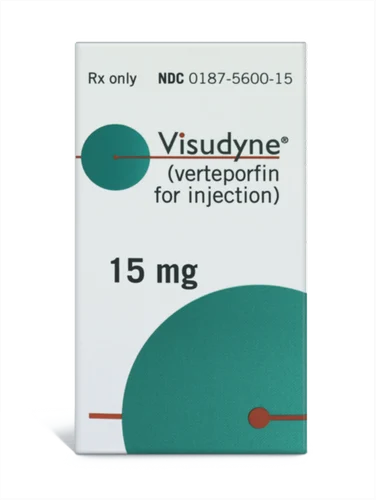Description
Visudyne Verteporfin , the brand name for Verteporfin, is a specialized medication used to treat age-related macular degeneration (AMD) and other retinal conditions. As a photosensitizer, Visudyne is utilized in photodynamic therapy (PDT) to target and destroy abnormal blood vessels in the eye, thereby helping to preserve vision and manage various ocular conditions.
Visudyne 15mg Injection
Visudyne 15 mg buy online
Verteporfin buy online
verteporfin
What is Visudyne (Verteporfin)?
Visudyne Verteporfin is a photosensitizing agent used in photodynamic therapy for the treatment of certain eye conditions, including age-related macular degeneration (AMD). It works by accumulating in abnormal blood vessels in the retina. When exposed to a specific type of laser light, Visudyne is activated, causing the destruction of these blood vessels and reducing vision loss.
Key Benefits of Visudyne
- Effective AMD Treatment: Visudyne is highly effective in treating wet AMD, a condition where abnormal blood vessels form beneath the retina, causing vision loss.
- Preservation of Vision: By targeting and destroying abnormal blood vessels, Visudyne helps to stabilize or improve vision in patients with retinal conditions.
- Minimal Invasiveness: The photodynamic therapy using Visudyne is a non-invasive treatment that targets problem areas without the need for surgery.
- FDA-Approved: Visudyne is approved by the FDA for use in treating specific retinal conditions, ensuring its efficacy and safety.
How Visudyne Works
Visudyne Verteporfin works through a process called photodynamic therapy (PDT). After intravenous administration, Visudyne accumulates in abnormal blood vessels in the retina. A specific wavelength of laser light is then directed at the affected area, activating the drug. This activation causes a reaction that destroys the abnormal blood vessels, reducing leakage and minimizing vision loss.
Dosage and Administration
- Dosage: Visudyne Verteporfin is administered intravenously, with the dosage typically determined based on the specific condition being treated and the patient’s overall health.
- Administration: The treatment involves a single infusion of Visudyne, followed by exposure to a laser light within 15 minutes of the infusion. The procedure is usually performed in a specialized clinic or hospital.
What to Expect During Visudyne Treatment
Patients undergoing treatment with Visudyne may experience some side effects, including temporary vision changes, light sensitivity, and redness at the injection site. The treatment itself is generally well-tolerated, and many patients report stabilization or improvement in their vision following therapy. Regular follow-up appointments are necessary to monitor progress and assess the effectiveness of the treatment.
Safety and Precautions
- Photosensitivity: After treatment with Visudyne, patients should avoid direct sunlight and bright lights for a period of 48 hours to prevent potential skin reactions.
- Allergies and Reactions: Inform your healthcare provider if you have a history of allergies or adverse reactions to medications, as these may affect your suitability for treatment with Visudyne.
- Medical Conditions: Discuss any pre-existing medical conditions, particularly those affecting the liver or eyes, with your healthcare provider before starting treatment.
Visudyne 15mg Injection
Visudyne 15 mg buy onlineVerteporfin buy online
verteporfin
Why Choose Visudyne?
Visudyne offers a valuable option for treating age-related macular degeneration and other retinal conditions that involve abnormal blood vessels. Its ability to target and destroy these vessels with minimal invasiveness makes it a preferred choice for preserving vision and managing ocular diseases. If you are dealing with AMD or similar conditions, Visudyne may be an essential part of your treatment plan.
Explore our retinal condition treatments and vision preservation options for additional support and resources.









